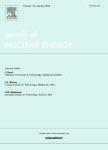版权所有:内蒙古大学图书馆 技术提供:维普资讯• 智图
内蒙古自治区呼和浩特市赛罕区大学西街235号 邮编: 010021

作者机构:State Key Laboratory of Multiphase Flow in Power Engineering School of Nuclear Science and Technology Xi’an Jiaotong University Xi’an City 710049 China Science and Technology on Reactor System Design Technology Laboratory Nuclear Power Institute of China Chengdu 610213 China
出 版 物:《Annals of Nuclear Energy》
年 卷 期:2016年第94卷
页 面:44-54页
学科分类:08[工学] 0827[工学-核科学与技术]
主 题:Dual-cooled annular fuel Heat split FROBA-ANNULAR code MDNBR
摘 要:In this study, the mechanisms that cause heat split, a specific phenomenon in dual-cooled annular fuel elements, were investigated. On the basis of thermal resistance analysis, the developing process of heat split phenomenon was summarized. It was found that thermal expansion, fuel densification, swelling, creep, relocation and fission gas release are the original parameters driving the development of heat split. Due to these factors, thermal resistances for heat flux to internal and external channels change with the operating time, which results in heat split. Furthermore, the theoretical simulation on heat split was performed by FROBA-ANNULAR, which is a coupled thermal–mechanical analysis code for dual-cooled annular fuel elements. Key parameters at different burnup stages, including gap size, gap conductance, temperature profile, coolant flux and heat flux were obtained. The calculation result shows that the fraction of heat flux to the internal cooling channel experiences complicated variation at the range of 32.9–39.7%. In addition, it was found that heat split does not match with the coolant split, especially at the lower burnup stage. Asymmetric heat transfer occurred because of the imbalance between heat split and coolant split, resulting in a substantial asymmetric temperature profile. Furthermore, heat split exerts an influence on DBNRs of inner and outer channels, although the computational values were still within the allowable limits.